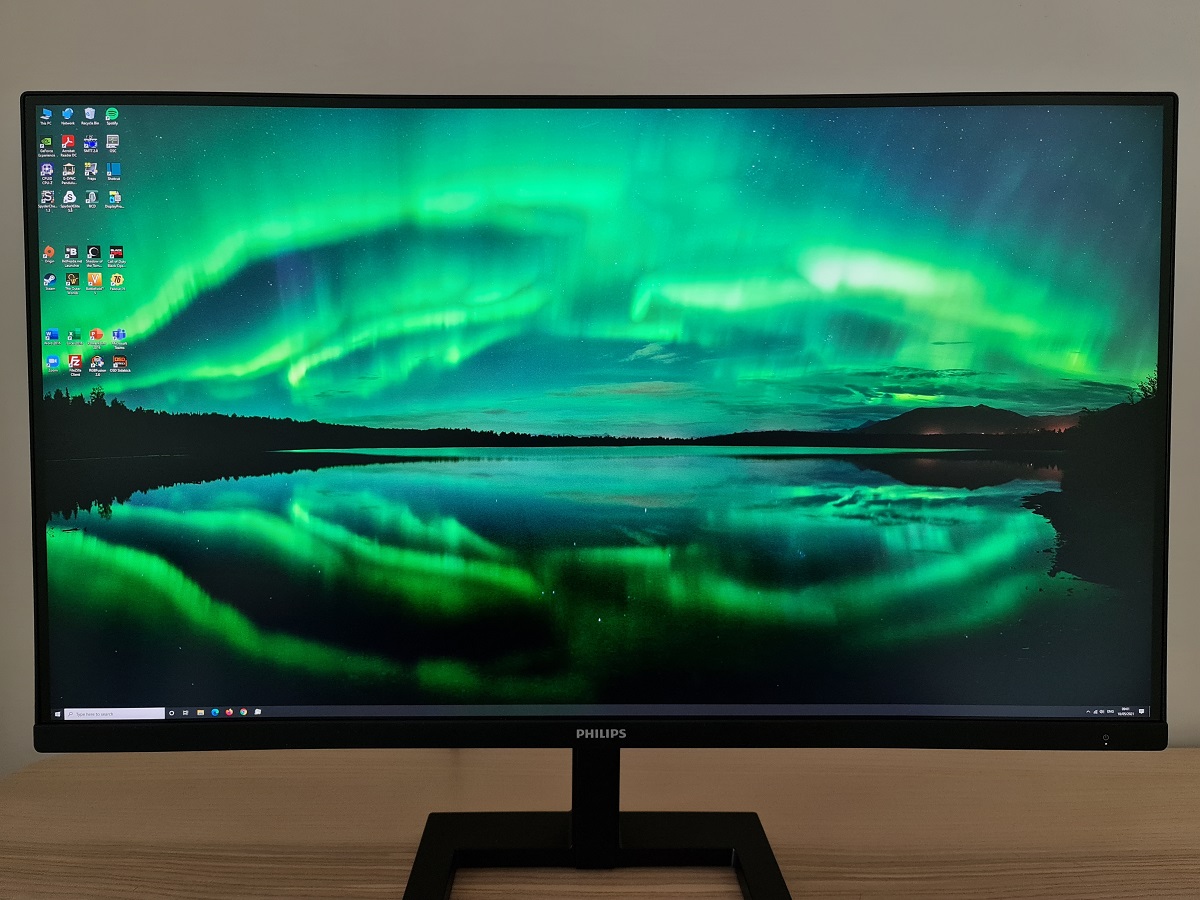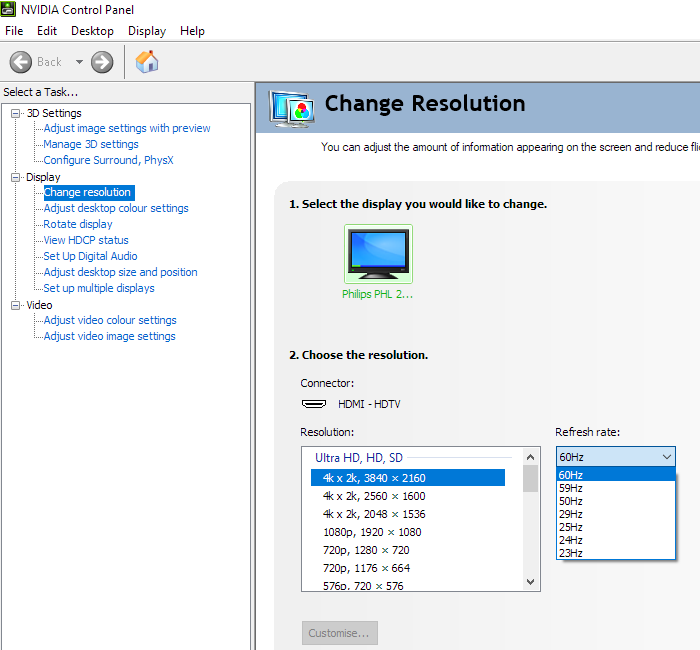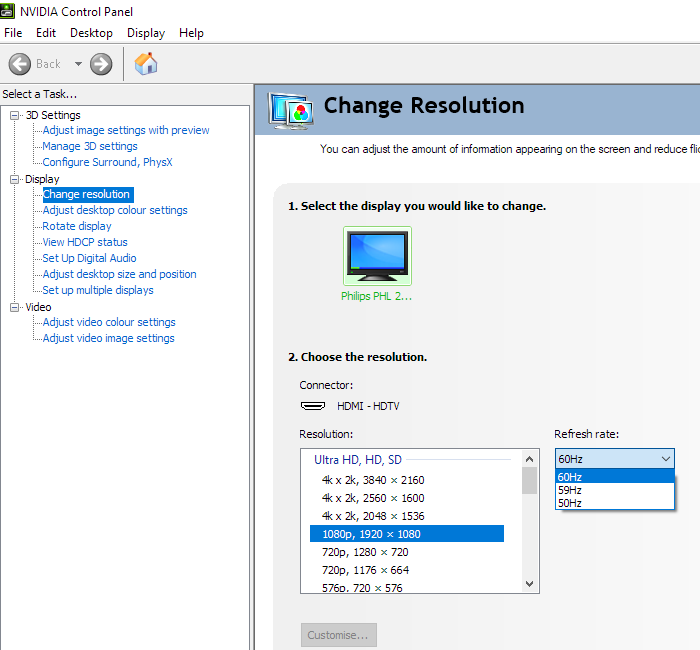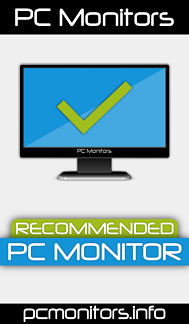Author: Adam Simmons
Date published: May 18th 2021
Table of Contents
Introduction
When it comes to clarity and detail the 3840 x 2160 (‘4K’ UHD) resolution on a 27 – 28” screen can be very attractive. The Philips 288E2UAE (288E2E) offers this pixel-dense experience, coupling it with a colour-focused IPS-type panel. Although not a ‘gaming monitor’, strictly speaking, the monitor is designed to accommodate 60Hz gaming. With support for Adaptive-Sync, including AMD FreeSync. We put this model through its paces in our usual suite of ‘real world’ tests.
Specifications
The monitor uses a 28” IPS (In-Plane Switching) type panel from Innolux. Or AAS (Azimuthal Anchoring Switch) as Innolux refers to it. This includes a 60Hz refresh rate with support for 10-bit colour (8-bit + FRC dithering). A 4ms grey to grey response time is specified, but as usual you should be sceptical of such figures. Some of the key ‘talking points’ for this monitor have been highlighted in blue below, for your reading convenience.
The monitor has a homely-looking square design. The stand base is a rectangular ring, matte black plastic with a brushed texture. The bottom bezel is matte black plastic, ~15mm (0.59 inches) thick with just a sliver of panel border. The top and side bezels are dual-stage, including a slim panel border flush with the rest of the screen and a slim hard plastic outer component. Including both components the bezels are ~6.5mm (0.26 inches) at the top and ~7.5mm (0.30 inches) at the sides. The screen has a light to very light matte anti-glare finish, explored shortly. The OSD is controlled by a joystick at the rear of the monitor, towards the right side as viewed from the front. A small pinprick-style power LED faces forwards towards the right side of the bottom bezel. Glowing a fairly gentle white when the monitor is on and flashing white when it enters a low power state. The following video runs through the menu system and OSD controls, including the 2-device PiP and PbP functionality. 3840 x 2160 @60Hz can be leveraged using suitable versions of HDMI and DP. Adaptive-Sync is supported via AMD FreeSync (HDMI and DP) and Nvidia’s ‘G-SYNC Compatible Mode’ (DP). A power cable and adaptor plus HDMI cable is included as standard. A DP cable is also included with the ‘E2UAE’. Additional accessories depend on region. The first image below shows the refresh rates supported for the native 3840 x 2160 (‘4K’ UHD) and indeed lower resolutions including 2560 x 1440 (WQHD) and 1920 x 1080 (Full HD) when using DisplayPort. These refresh rates are also supported for the ‘4K’ UHD resolution via HDMI – they’re categorised in the EDID of the monitor as ‘PC’ resolutions. 60Hz but not 30Hz is listed for WQHD via HDMI. Additional refresh rates are supported via HDMI and categorised in the EDID as ‘TV’ resolutions. Nvidia Control Panel lists these as ‘Ultra HD, HD, SD’ and they can be accessed by other devices such as the PS5 and Xbox Series X. The second image shows these for the ‘4K’ UHD resolution and the third image for the Full HD resolution. The image below is a macro photograph taken on Notepad with ClearType disabled. The letters ‘PCM’ are typed out to help highlight any potential text rendering issues related to unusual subpixel structure, whilst the white space more clearly shows the actual subpixel layout alongside a rough indication of screen surface. This model uses a light to very light matte anti-glare screen surface. This offers reasonable glare handling, whilst offering fairly direct emission of light. There isn’t a clear layered appearance in front of the image, whilst vibrancy and clarity is better maintained than on stronger matte surfaces. In brighter conditions, light striking the screen surface can give a ‘glassy’ look when observing some content. But the glare handling is far superior to a glossy surface or even lighter matte screen surfaces. The screen surface texture is not as smooth as it could be, giving lighter content a bit of a grainy look. Not the sort of heavily sanded look we’ve seen on some models, but not the smoothest look either. Most users should find this level of graininess fine or simply not really notice. The 288E2UAE (288E2E) features a range of ‘SmartImage’ presets; ‘FPS’, ‘RTS’, ‘Gamer1’, ‘Gamer2’, ‘LowBlue Mode’, ‘EasyRead’ and ‘SmartUniformity’. Many of these presets simply adjust various settings in the OSD and don’t achieve anything you couldn’t achieve yourself with manual adjustment. A notable exception is ‘SmartUniformity’, explored here alongside a range of other manual adjustments. And ‘Easy Read’ which turns everything greyscale. All presets except ‘Easy Read’ and ‘Off’ unlock the ‘SmartFrame’ feature which allows a section of the screen to be highlighted with different digital brightness and contrast levels. The ‘Gamer 1’ and ‘Gamer 2’ presets allow full flexibility and allow you to easily recall different sets of settings. We touch upon the presets briefly in the OSD video but for this section will mainly be focusing on various manual adjustments, the ‘LowBlue Mode’ settings and the ‘SmartUniformity’ setting. The table below includes gamma and white point readings taken using a Datacolor SpyderX Elite colorimeter. General observations on the image are also provided. Our test system uses Windows 10 and an Nvidia RTX 3090 connected using a DP cable. Additional testing was performed with an AMD Radeon RX 580 and also using HDMI, but our observations on this table were not significantly affected by this. An important step also had to be performed in the graphics driver if connected to an Nvidia GPU via HDMI. The colour signal had to be corrected to a ‘Full Range RGB’ signal as detailed in this article. No additional monitor drivers or ICC profiles were specifically loaded. The monitor was left to run for over 2 hours before readings were taken or observations made. Aside from our ‘Test Settings’ where various adjustments are made, assume factory defaults are used. An exception was that we disabled ‘DPS’ (Dynamic Power Saving) for consistency, a setting which dims the screen slightly when mostly dark content is displayed. When viewing the figures in this table, note that for most PC users ‘6500K’ for white point and ‘2.2’ for gamma are good targets to aim for. Individual targets depend on individual uses, tastes and the lighting environment, however.
*10-bit can be selected in the graphics driver when using a DP signal at any refresh rate, up to the native resolution. 10-bit and 12-bit can be selected when using HDMI at up to 30Hz for the native resolution. Or at up to 60Hz for lower resolutions such as WQHD and Full HD. 12-bit includes an additional 2-bit dithering stage added by the monitor’s scaler to facilitate work with higher bit depth content.
As an Amazon Associate I earn from qualifying purchases made using the below link. Where possible, you’ll be redirected to your nearest store. Further information on supporting our work.
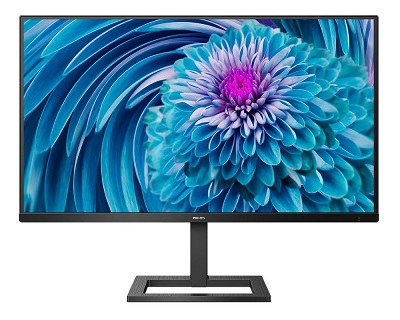
Features and aesthetics
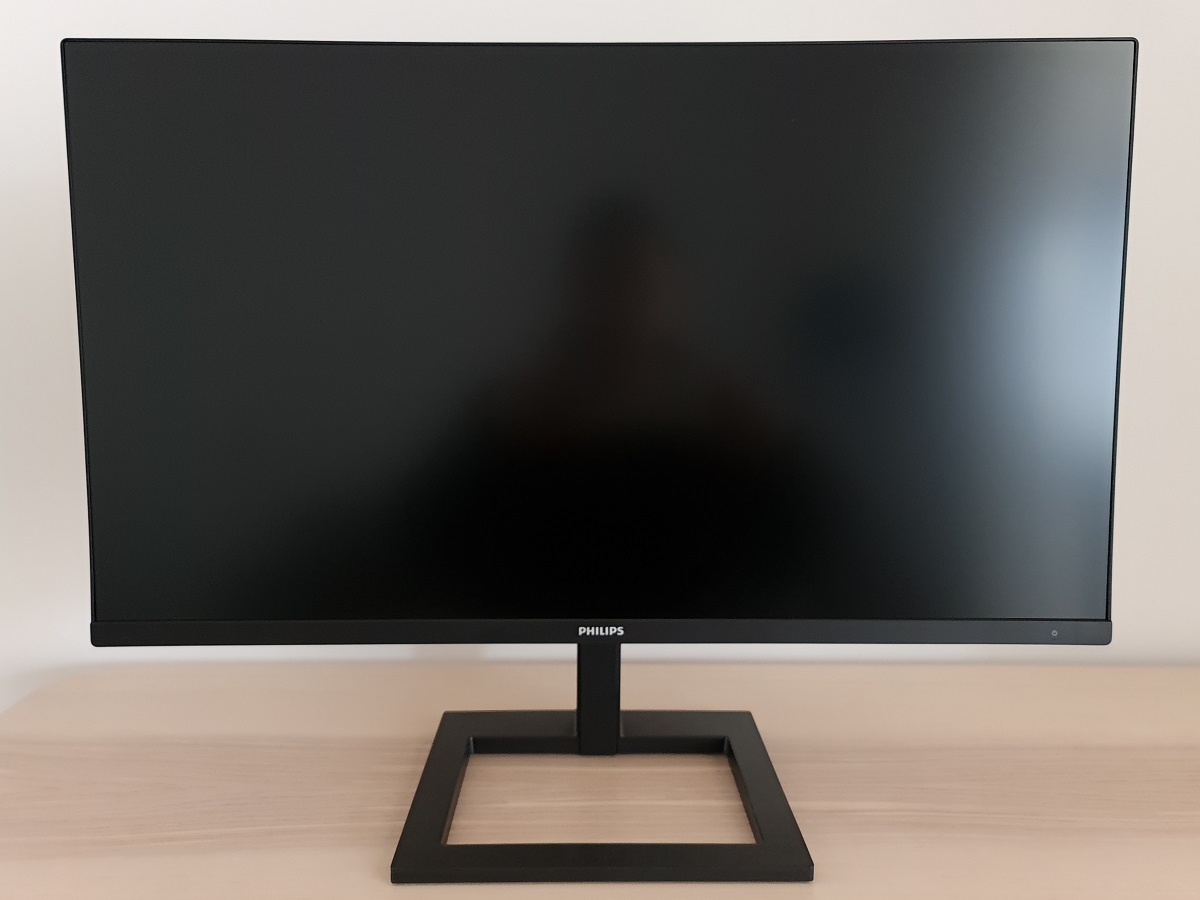
From the side the monitor is slim at thinnest point, ~14mm (0.55 inches). The monitor bulks out lower down where the stand attaches. The included stand offers tilt (5° forwards, 20° backwards) and height (100mm or 3.94 inches) adjustment. At lowest stand height, the monitor sits ~26mm (1.02 inches) above the desk surface with the top of the screen ~393mm (15.47 inches) above the desk. The total depth of the monitor – including the integrated cable tidy feature at the back – is ~233mm (9.17 inches), with the screen sitting ~80mm (3.15 inches) back from the front edge of the screen. So you can place the screen reasonably close to the wall if you want.
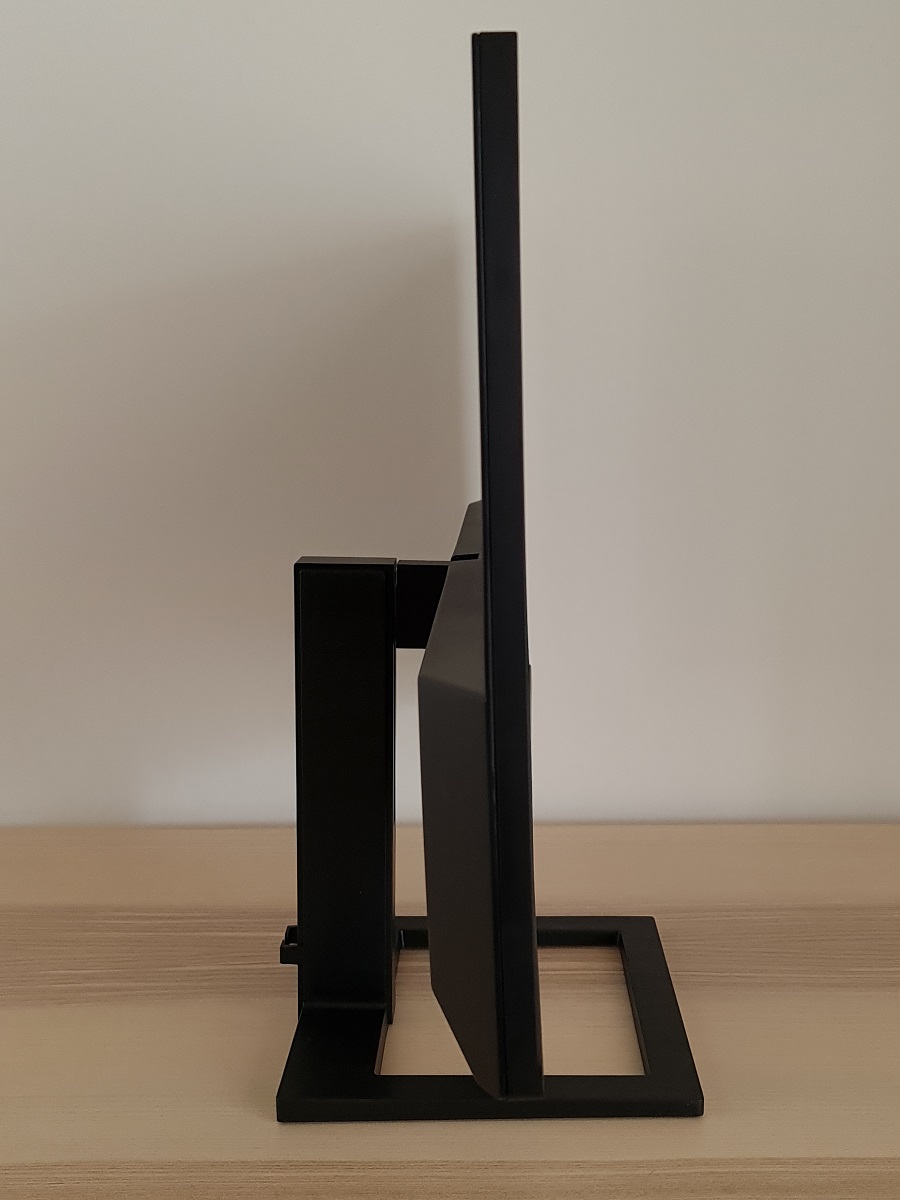
The rear of the monitor makes extensive use of matte black plastic. The stand attaches using a quick release mechanism, detachable by pushing up a switch beneath the attachment point. This reveals 100 x 100mm VESA holes for alternative mounting. A K-Slot is located beneath the OSD joystick, to the left. The ports are found towards the right in a recessed area and include; DC power (external ‘power brick’), HDMI 2.0, DP 1.2a and a 3.5mm audio output. The ‘E2UAE’ model includes 4 USB 3.2 ports (yellow coloured supporting BC 1.2 fast-charging) plus upstream. It also includes 2 x 3W backwards-facing speakers near the bottom of the screen. These offer basic sound output, with reasonable volume but not a particularly rich or crisp sound. A bit fuller than the output of some integrated speakers but far from the best we’ve heard. The ‘E2E’ model includes an additional HDMI 2.0 port but offers no USB functionality or integrated speakers. In some regions a 288E2A variant is available with tilt-only stand, 2 HDMI 2.0 ports, an audio input and speakers but no USB ports.
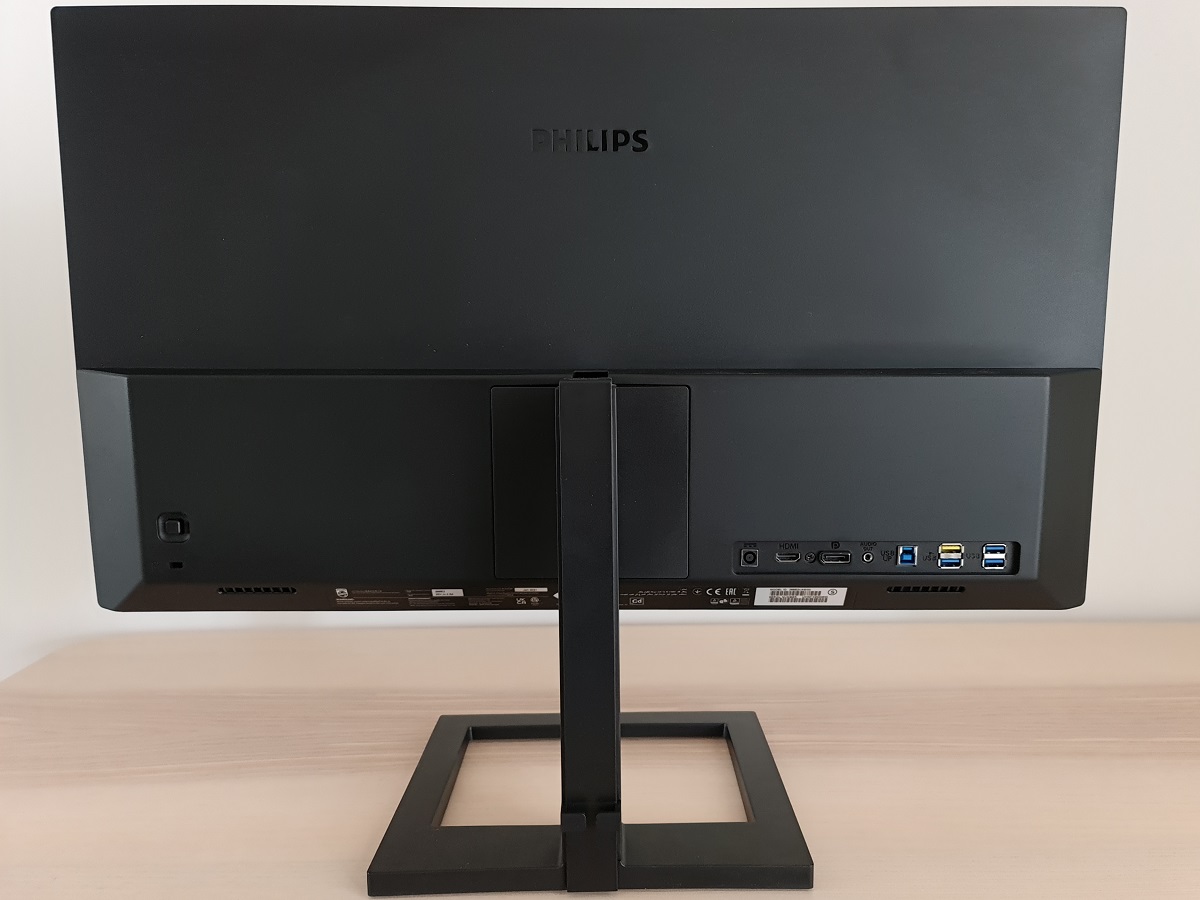
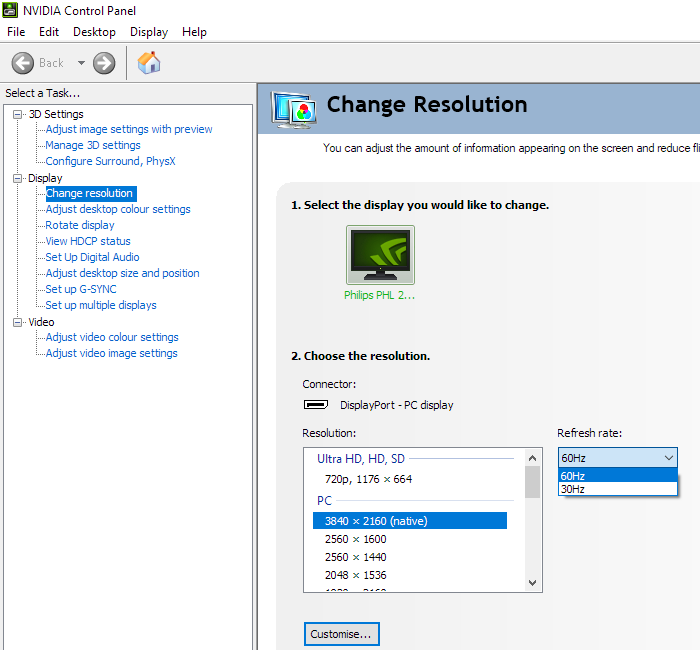
Calibration
Subpixel layout and screen surface
![]()
As shown above the standard RGB (Red, Green and Blue) stripe subpixel layout is used. This is the default expected by modern operating systems such as Microsoft Windows. Apple’s MacOS no longer uses subpixel rendering and therefore doesn’t optimise text for one particular subpixel layout to the detriment of another. You needn’t worry about text fringing from non-standard subpixel layouts and won’t need to change the defaults in the ‘ClearType Text Tuner’ as a Windows user. You may still wish to run through the ClearType wizard and adjust according to preferences, however. The subpixels are quite ‘squat’ with relatively large gaps above and below. On some models this contributes to ‘static interlace pattern artifacts’ and can affect text and fine-edge clarity. On this model we observed no such issues, likely as the pixel density is so high that the gaps above and below the subpixels are still tiny. We therefore had no subpixel-related concerns related to sharpness or text clarity on this model.
Testing the presets
Monitor Settings Gamma (central average) White point (kelvins) Notes Gamma = 1.8 1.9 6513K A somewhat flooded look with lack of depth due to gamma, good balance otherwise. Gamma = 2.0 2.0 6514K As above but a bit of extra depth. Gamma = 2.2 (Factory Default) 2.2 6532K A look which is quite vibrant with good balance and variety. Gamma tracking appropriate for the ‘2.2’ curve. Gamma = 2.4 2.5 6508K As above some extra depth due to increased gamma. Gamma = 2.6 2.6 6538K As above with a yet more extra depth. A deep and cinematic look, poor distinction for very dark shades. Low Blue Mode = 1 2.4 5578K A moderately effective Low Blue Light (LBL) setting. The image appears somewhat warmer than default with a fair reduction in blue light output due to weakened blue channel. Slight yellowish green tint due to green channel remaining strong. Low Blue Mode = 2 2.4 4954K A highly effective LBL setting. The image appears warm with a clear yellowish green tint. Your eyes adjust to some extent over time, but not entirely. The blue colour channel is weakened by a very large degree, reducing blue light output very effectively. Low Blue Mode = 3 2.4 4832K As above but dimmer by default. Low Blue Mode = 4 2.4 4775K As above with very slightly stronger blue light reduction. Color Temperature = 5000K 2.2 4978K An alternative LBL setting. Effective in reducing blue light output, especially when combined with a reduced brightness. Doesn’t give the same yellowish green tint as the green channel is somewhat reduced as well. Color = sRGB 2.4 6638K An sRGB emulation modes. The gamut is clamped so it follows sRGB quite closely. The full factory calibration is (supposedly) based on this, but the gamma tracks ‘2.4’ on average on our unit with significant bowing and can’t be adjusted in the OSD. Some shades appear quite a bit deeper than intended. Quite well balanced with respect to white point and colour channels, however. Brightness locked at default value, which is quite a reasonable and comfortable level for most. Color = User Define 2.4 6290K Gamma tracks in a similar way to the sRGB setting, poor adherence to ‘2.2’ curve. Colour temperature a bit warmer than factory default and green channel a touch too strong. Color = User Define (Gamma 2.0) 2.2 6285K As above but gamma corrected, now tracking the ‘2.2’ curve well. SmartImage= SmartUniformity 2.0 6566K A Uniformity Compensation (UC) setting designed to even brightness out across the screen (we explore this later). As usual, this comes at the expense of contrast. The gamma curve bows significantly for mid to brighter tones, so they’re significantly lighter than they should be. SmartImage= SmartUniformity (Gamma = 2.4) 2.2 6574K As above but gamma tracks closer to 2.2. Still skewed for some mid to bright shades so they appear too bright and some darker shades a touch too dark. But better than before with a good uplift of depth in comparison. Test Settings (see below) 2.2 6531K As factory defaults, no need for further adjustment to hit desired targets for brightness, gamma or white point and overall colour channel balance.
The setup of our unit was right where we wanted it straight from the box. The image was quite vibrant, consistent and well-balanced with respect to colour channels and gamma. Even brightness was right where we’d usually set it, which is very rare to see. The gamma tracking is altered if you switch away from one of the predefined ‘Colour Temperature’ settings, however. Fortunately, on our unit that simply meant you’d switch the gamma over to ‘2.0’ if you wished to manually adjust colour channels. Which yielded good tracking of the ‘2.2’ curve. The following image shows gamma tracking under our ‘Test Settings’, identical to the factory defaults. Strong adherence to the ‘2.2’ curve ‘out of the box’, in other words. The monitor includes an sRGB emulation setting (‘sRGB’) which the full factory calibration is supposed to be based on, as well as a pre-tuned ‘SmartUniformity’ Uniformity Compensation (UC) setting. A calibration report is included which is unique to each unit, showing its compliance in terms of gamma and colour accuracy (DeltaE deviation) for specific shades with the ‘sRGB’ setting. Plus colour and brightness uniformity using the ‘SmartUniformity’ setting. Both settings are described in the table, but as noted there the gamma tracking was really not where it should be. And didn’t correspond to the value given in the report for the ‘sRGB’ setting nor could it be adjusted in the OSD with this setting. The tracking was off regardless of whether we were using DP or HDMI or indeed using our AMD or Nvidia GPU. We’ve seen this sort of thing with other models before, but we were at least pleased to see strong gamma tracking using the full native gamut (including factory defaults) in this case. The monitor includes various Low Blue Light (LBL) settings. The main settings are referred to as ‘LowBlue Mode’ settings, with 4 levels of effectiveness. The weakest setting (‘1’) was already moderately effective, with the remaining settings even more effective at reducing the blue colour channel and minimising blue light output from the monitor. The green channel remained strong, which helps maintain strong contrast. But it also affected image balance, giving a yellowish green tint that our eyes only partially adjusted to over time. We preferred the alternative LBL setting, ‘Color Temperature = 5000K’. This was still highly effective but also better balanced due to the green channel also being reduced somewhat. We used this setting for our own viewing comfort in the evenings, but not for specific testing aside from that involving the setting itself. Cutting out stimulating blue light is important in the hours leading up to bed as it affects sleep hormones and keeps the body ‘alert’ even if it should be winding down. We tied our ‘Test Settings’ to the ‘Gamer 1’ preset and our preferred evening LBL setup to ‘Gamer 2’. You can easily switch between these or other presets by nudging the joystick left before entering the main menu. For our ‘Test Settings’ we simply switched the ‘SmartResponse’ setting to ‘Fastest’. We were happy to leave the remaining settings as they were as our unit hit our preferred targets. We also disabled ‘DPS’ (Dynamic Power Saving) as noted earlier, for consistency and to avoid unwanted dimming of the screen. This isn’t a setting you can use in most presets anyway, including ‘Gamer1’ and ‘Gamer2’. Note that individual units and preferences vary, so these settings are simply a suggestion and won’t be optimal for all users or units. SmartImage = Off Brightness= 80 (according to preferences and lighting) DPS= Off SmartResponse= Fast Color= 6500K

Gamma 'Test Settings'

The first image below shows the gamma curve using the ‘sRGB’ setting – note the significant ‘bowing’ for various mid-tones which makes many shades deeper than intended. Despite saturation being curtailed overall due to the clamped gamut, which does work effectively. The second image below shows gamma tracking with the ‘SmartUniformity’ setting. The gamma is set to ‘2.4’ which gave the best adherence to the desired ‘2.2’ curve on our unit. There’s still some deviation as described in the table, but it’s not too extreme and certainly better than the ‘SmartUniformity’ using the default ‘2.2’ gamma setting.
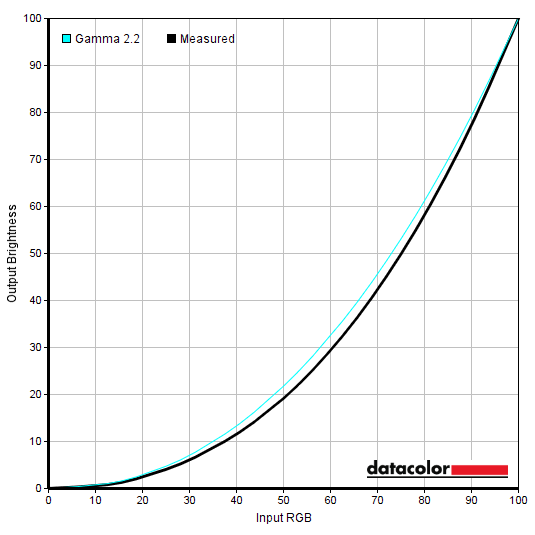
Gamma 'sRGB'
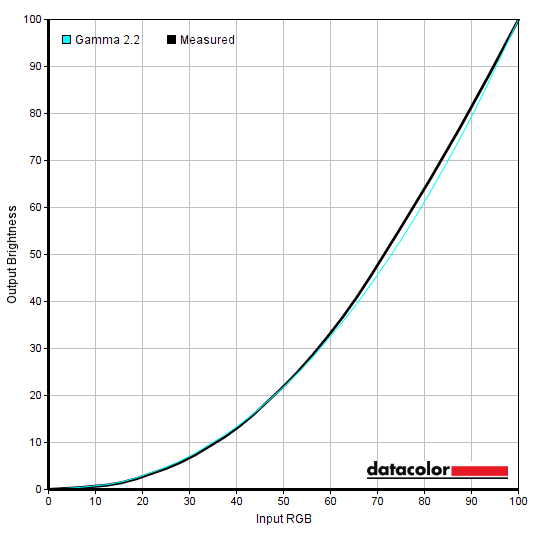
Gamma 'SmartUniformity' (Gamma 2.4)
Given inter-unit variation and the excellent adherence to our preferred targets ‘out of the box’, we will not be using any ICC profiles in this review or including any measurements or graphs using them. We wouldn’t recommend using them unless created for your specific unit using your own calibration device. But we appreciate some users still like to use profiles and some aspects such as gamut mapping for colour-aware applications can be useful. You can download our ICC profile for this model, which was created using our ‘Test Settings’ as a base. You can also download our sRGB profile which was created using and designed for the ‘sRGB’ setting (sRGB emulation mode). Amongst other things, this shifts gamma so it adheres to our usual target of the ‘2.2’ curve. Be aware of inter-unit variation and note again that these ICC profiles are not used in the review.
Test Settings
Contrast and brightness
Contrast ratios
We used an X-Rite i1Display Pro to measure white and black luminance levels, from which static contrast ratios could be calculated. The table below shows this data, with various settings used. Assume any setting not mentioned was left at default, except for the changes already noted in the calibration section. Black highlights indicate the highest white luminance, lowest black luminance and maximum contrast ratio recorded. Blue highlights indicate the results under our ‘Test Settings’.
| Monitor Settings | White luminance (cd/m²) | Black luminance (cd/m²) | Contrast ratio (x:1) |
| 100% brightness | 250 | 0.24 | 1042 |
| 80% brightness (Factory Defaults) | 167 | 0.16 | 1044 |
| 60% brightness | 145 | 0.14 | 1036 |
| 40% brightness | 123 | 0.12 | 1025 |
| 20% brightness | 100 | 0.09 | 1111 |
| 0% brightness | 76 | 0.07 | 1086 |
| Gamma = 1.8 | 168 | 0.16 | 1050 |
| Gamma = 2.0 | 168 | 0.16 | 1050 |
| Gamma = 2.4 | 168 | 0.16 | 1050 |
| Gamma = 2.6 | 167 | 0.16 | 1044 |
| Low Blue Mode = 1 | 255 | 0.24 | 1063 |
| Low Blue Mode = 2 | 268 | 0.24 | 1117 |
| Low Blue Mode = 3 | 166 | 0.15 | 1107 |
| Low Blue Mode = 4 | 166 | 0.15 | 1107 |
| Color Temperature = 5000K | 156 | 0.16 | 975 |
| Color = sRGB | 164 | 0.16 | 1025 |
| Color = User Define | 184 | 0.16 | 1150 |
| Color = User Define (Gamma = 2.4) | 184 | 0.16 | 1150 |
| Color = User Define (100% brightness) | 277 | 0.24 | 1154 |
| SmartImage= SmartUniformity | 180 | 0.24 | 750 |
| SmartImage= SmartUniformity (Gamma = 2.4) | 181 | 0.24 | 754 |
| Test Settings | 167 | 0.16 | 1044 |
The average contrast ratio with only brightness adjusted was 1057:1, just slightly exceeding the specified value and quite reasonable for the panel type. The maximum contrast recorded was 1154:1 using ‘Color = User Define’ at full brightness. Our ‘Test Settings’ did not involve any contrast-changing adjustments, so we recorded a perfectly respectable 1044:1. Setting ‘Color Temperature’ to ‘5000K’ reduced the contrast just slightly (975:1) due to the significant changes made to colour temperature, including the green colour channel being reduced. The biggest contrast dip came after enabling ‘SmartUniformity’ (750:1 – 754:1). A reduction in contrast is usual for such a setting as it’s a Uniformity Compensation (UC) mode, reducing digital brightness at some points of the screen and making other adjustments to even things out overall. The maximum luminance recorded on this table was 277 cd/m², whilst the minimum recorded was 76 cd/m². This gives a luminance adjustment range of 201 cd/m², quite limited and slightly below specification at the top end. And not going as dim as sensitive users might like. Most users target 100 – 200 cd/m² which this model accommodate – but personal preferences, sensitivity and lighting environments vary so better flexibility would be preferred.
The monitor includes a Dynamic Contrast setting called ‘SmartContrast’, which allows the backlight brightness to adjust (as a single unit) at a moderate pace according to the levels of light and dark being displayed on the screen. The brightness setting isn’t locked off when using this setting, but is ignored after the setting has been doing its thing for a short while. We found the setting tended towards a higher brightness than we’d like for mixed to lighter content, although it dimmed reasonably effectively for predominantly dark content. As usual this Dynamic Contrast mode is a compromise which can’t properly compensate for intricate mixtures of light or dark on the screen. The constant adjustments can also be bothersome and aren’t generally optimal – we therefore prefer manual brightness control.
PWM (Pulse Width Modulation)
The 288E2UAE (288E2E) does not use PWM (Pulse Width Modulation) to regulate backlight brightness at any level. Instead, DC (Direct Current) is used to moderate brightness. The backlight is therefore considered ‘flicker-free’, which will come as welcome news to those sensitive to flickering or worried about side-effects from PWM usage.
Luminance uniformity
Whilst observing a black background in a dark room, using our ‘Test Settings’, we noticed moderate backlight bleed and some clouding towards the corners of the screen, particularly the top left. It’s important to note that individual units vary when it comes to all aspects of uniformity, including backlight bleed and clouding. The following image was taken a few metres back to eliminate ‘IPS glow’. This is bluish silver glow that creates a haze that emanates from the edges of the screen, particularly near the bottom corners from a normal viewing position. This ‘IPS glow’ blooms out more strongly from steeper angles, as demonstrated in the viewing angles video later. The luminance uniformity using our ‘Test Settings’ was variable. The maximum luminance was recorded at ‘quadrant 2’ above centre (164.8 cd/m²). The greatest deviation from this occurred at ‘quadrant 9’ towards the bottom right of the screen (140.1 cd/m², which is 15% dimmer). The average deviation between each quadrant and the brightest recorded point was 8.45%, which is reasonable. The ‘SmartUniformity’ setting offered somewhat improved performance in this test. The maximum luminance was recorded at ‘quadrant 1’ towards the top left (184.8 cd/m²). The greatest deviation from this occurred at quadrant 6 (166.7 cd/m², which is 10% dimmer). The average deviation between each quadrant and the brightest recorded point was reduced slightly to 6.25%, quite respectable although not as good as we’ve seen from such a setting. Even if the setting was optimised very carefully in the factory, uniformity can shift over time. Remember that individual units vary when it comes to uniformity and you can expect further deviation beyond the points measured. The contour map below shows these deviations graphically, with darker greys representing lower luminance (greater deviation from brightest point) than lighter greys. The percentage deviation between each quadrant and the brightest point recorded is also given. The top table shows the results under our ‘Test Settings’, the bottom using ‘SmartUniformity’ with default settings. The SpyderX Elite was also used to analyse variation in the colour temperature (white point) for the same 9 quadrants. The deviation between each quadrant and the quadrant closest to the 6500K (D65) daylight white point target was analysed and a DeltaE value assigned. Darker shades are also used on this map to represent greater deviation from 6500K. A DeltaE >3 represents significant deviation that may be readily noticed by eye. The top graphic shows results under our ‘Test Settings’ and the bottom using ‘SmartUniformity’ with default settings. Results here were decent using our ‘Test Settings’. Significant but not extreme deviation was recorded towards the top left (DeltaE 3.3) and top central region (DeltaE 3.2), with the bottom left recorded as closest to 6500K. The ‘SmartUniformity’ setting improved the colour temperature uniformity, with no significant deviation recorded. Note again that individual units vary when it comes to uniformity and that you can expect deviation beyond the measured points. The monitor provided a reasonable contrast performance on Battlefield V. With a static contrast ratio of 1044:1 under our ‘Test Settings’, the monitor didn’t give dark scenes the same depth and atmosphere as screens with much stronger contrast (VA models, typically). Particularly when observed in a dimly lit room. It edged out some IPS models in this respect, but some are a bit stronger. An overriding feature in dimmer lighting in particular was ‘IPS glow’, observed most strongly towards the bottom corners of the screen from a normal viewing position. A cool-tinted greenish grey haze from most angles which ate away at detail and atmosphere. We observed as moderate and fairly normal amount of this overall, although it was brought out a bit more strongly on our unit due to some backlight bleed and clouding. It can also be brought out more strongly if using a higher brightness setting or sitting closer to the screen. The strong gamma consistency of the monitor prevented the clear detail shifts observed on TN models (top to bottom) or VA models (centre vs. edges) for darker content. There was slight masking of dark detail due to the gamma setup under our ‘Test Settings’, but this was quite tame. For brighter shades the we observed slight graininess from the screen surface, but not an obvious layered appearance due to the light to very light matte quality. Shadow of the Tomb Raider told a similar story. This title craves a strong contrast performance as there are plenty of dimly lit areas such as caves and passageways illuminated by a few point sources of light. The monitor, again, did not give such scenes a deep or atmospheric look. Especially when observed in a dimly lit room. A touch stronger than some IPS models, but some are stronger in this respect. A moderate amount of ‘IPS glow’ was observed, further eating away at the atmosphere in affected regions of the screen. Strong gamma consistency was again observed, without the banded or ‘blocky’ appearance that TN and some VA models can give in certain regions of the screen. There was again slight masking of some detail due to the slight raising of gamma for some darker shades – but nothing severe. The screen surface gave a slightly grainy look to lighter content, but nothing heavy or layered. We also observed the film Star Wars: The Rise of Skywalker. As with Tomb Raider, there are plenty of scenes here which crave a strong contrast performance. Explosions, light sabers and pulses of energy lighting up dark backgrounds. The monitor didn’t deliver a particularly cinematic look here, particularly when observed in darker room lighting. Again, there was moderate ‘IPS glow’. This was all as expected for the panel type, with some IPS models again being a bit stronger and some a bit weaker. This film is shot in an UltraWide aspect ratio and as such has black bars at the top and bottom when viewed on a 16:9 monitor like this. This ‘letterboxed’ area made the aforementioned weaknesses in the contrast performance quite apparent. Most content on platforms including Netflix, Amazon Prime Video and YouTube does not have this issue as it fills the screen under 16:9. The screen surface imparted slight graininess, but again without the layering observed on stronger matte surfaces. The Lagom tests for contrast allow specific weaknesses in contrast performance to be identified. The following observations were made in a dark room. The colour gamut of the 288E2UAE (288E2E) is shown as a red triangle below. It was compared with the sRGB (green triangle) and DCI-P3 (blue triangle) reference colour spaces using our ‘Test Settings’. The gamut fully covers sRGB with some extension beyond – we recorded 87% DCI-P3 coverage. The red corner extends towards DCI-P3, whilst the gamut more closely tracks sRGB for the red to green edge. There is some extension beyond sRGB for other green and green to blue shades. Although not shown in the graphic, we recorded 82% Adobe RGB coverage. This DCI-P3 and Adobe RGB coverage isn’t high enough for accurate reproduction within those colour spaces. For standard sRGB content outside a colour-managed environment, things are represented with some extra vibrancy and saturation but not to an extreme degree. The monitor offers an sRGB emulation setting, accessed by changing ‘Color’ to ‘sRGB’ in the OSD. This cuts down on the gamut very effectively so it does not extend beyond sRGB, with a touch of under-coverage – 98% sRGB recorded. This setting locks off various settings in the OSD including gamma settings, colour channel adjustments and brightness. As covered earlier brightness is locked to a moderate value which most will be comfortable with (164 cd/m² recorded), but we all have our own preferences and viewing environments so flexibility here is preferred. To maximise colour accuracy within the sRGB colour space, for colour-managed workflows, full calibration and profiling with a colorimeter or similar device using the full native gamut is recommended. You may try the ICC profile featured in the calibration section which includes gamut mapping for colour-aware applications, but best results are always obtained by calibrating your own unit with your own hardware. Instead of using this ‘sRGB’ setting and putting up with the associated restrictions, AMD users can activate a flexible sRGB emulation setting via the graphics driver. This is done by opening ‘AMD Radeon Software’, clicking ‘Settings’ (cog icon towards top right) and clicking on ‘Display’. You should then ensure that the ‘Custom Color’ slider to the right is set to ‘Enabled’ and ‘Color Temperature Control’ set to ‘Disabled’. It may appear to be set this way by default, but the native rather than restricted gamut is likely in play. If that’s the case, simply switch the ‘Color Temperature Control’ slider to ‘Enabled’ then back to ‘Disabled’ to leverage the sRGB emulation behaviour. This setting is shown in the image below. The gamut below shows results using our ‘Test Settings’ with this driver tweak applied. The colour gamut now covers 99% sRGB with just a sliver of extension beyond in some regions. This offers even closer tracking of sRGB than the emulation mode and is a reliable way to cut down on the colour gamut without profiling, including in applications that aren’t colour managed. And you don’t have to put up with restrictions associated with the monitor’s sRGB emulation setting. The monitor provided quite a vibrant and suitably varied look on Battlefield V. This game and most other content you’ll consume is designed with the sRGB colour space in mind. With monitors like this offering some extension beyond the sRGB gamut, this invites extra saturation and a more vivid look as a result. This is different to the look you get with a digital saturation boost (e.g. increasing saturation in the graphics driver), which pulls shades closer to the edge of the gamut but doesn’t expand the gamut itself. That crushes things together and you loose shade variety, whereas with a wide gamut the most saturated shades are more saturated and good spacing is maintained between shades. As shown earlier it’s mainly some green and red regions of the gamut that show extension beyond sRGB. It’s not extreme extension and other green shades and red shades – including intermediates such as oranges and yellows – stick closer to sRGB. With 87% DCI-P3 coverage, the oversaturation is not as extreme as on some wide gamut models. The environments in this game showcased a nice variety of greens, including some quite deep and lush looking shades alongside more muted shades. Yellowish greens sometimes have the yellow component brought out a bit too strongly on wide gamut models, but that wasn’t readily observed here. Green shades appeared more natural and didn’t look as neon as they do on some wide gamut models. Reddish browns such as certain woody and earthy tones had as bit of a red push, but not to the extent of looking neon or ‘otherwordly’. This red push was not as extreme as on some models, but it gave a bit of extra red-biased richness in places. Fires were impressively vivid as a result, with yellows and bright oranges tending to look quite in-place but some deep oranges verging a bit on red. Dark red in-game markers had impressive depth to them, rather than the more neon red some wide gamut models would produce here. We made similar observations on Shadow of the Tomb Raider. The fairly generous gamut again invited some extra vibrancy and saturation, but not an extreme amount. Lara Croft’s skin and the skin tones of some other characters appeared a bit richer and more tanned than intended, but didn’t appear heavily tanned or sunburnt as some wide gamut models might show. Woody and earthy tones had red hues brought out a bit too strongly, although not by an extreme amount. There were definite licks of vibrancy for elements such as fires and some brightly painted objects. There were some impressively deep reds, in particular. The sky blues appeared just a bit more saturated than intended but didn’t have the sort of cartoonish level of oversaturation some models show. The greens of vegetation appeared lush and varied, without the yellow push or neon appearance given by models with a wider gamut. On both titles the excellent colour consistency shone through as well, with richness and saturation maintained very well throughout the screen. The sort of look the reasonably generous gamut gives is one some users will really enjoy – extra vibrancy but not an extreme degree of oversaturation. As explored earlier the monitor includes an sRGB emulation setting for those who prefer things sticking closer to the sRGB gamut. This gives a more subdued look in most cases, although our unit was calibrated such that average gamma was too high with that setting active (2.4). This gave extra depth to some shades, a curious juxtaposition. It also locks off access to brightness, as well as gamma and colour channels – inflexibility which is far from ideal. We also observed the animated TV series Futurama. With large areas of individual shade covering sections of the screen, this is a particularly unforgiving test for colour consistency. The monitor performed well here. Some shades such as the red of Dr Zoidberg appeared just a touch deeper at the extreme side edges and bottom of the screen. But there was nothing like the sort of shifts in saturation you’d observe on TN or VA models or even some weaker IPS-type models for that matter. The gamut injected a bit of extra vibrancy, so some pastel shades appeared a bit deeper than intended. But this was not extreme and shades that were intended to look more muted did so in comparison to deep or neon shades. Speaking of which, there were some impressively deep reds and dark greens showcased. Alongside some quite eye-catching neon shades – but only where they were intended to be shown in that way, we might add. The vibrancy of such elements wasn’t as eye-catching as we’ve seen on some models with more generous colour gamuts, but they still had good ‘pop’ to them and included some elements that were well beyond the boundaries of sRGB. The image below shows a printed reference sheet of 24 ‘sRGB’ shades, included as part of the Datacolor SpyderCHECKR 24 package. The screen is displaying reference photographs of this printed sheet, in both the same order as printed (right side) and reverse order (left side). The camera is mounted slightly above centre so that the image is representative of what the eye sees from an ergonomically correct viewing position. This, coupled with the inclusion of a flipped version of the shade sheet, allows both accuracy and colour consistency to be visually assessed. Bracketed numbers in our analysis refer to shades on the printed sheet or right side of the screen if they’re ordered consecutively from top left to bottom right. Note that there is always some disparity between how emissive objects (monitor) and non-emissive objects (printed sheet) appear. The representation of shades in this image depends on the camera and your own screen, it’s not designed to show exactly how the shades appear in person. It still helps demonstrate some of the relative differences between the original intended sRGB shade and what the monitor outputs, however. Full profiling and appropriate colour management on the application would provide a tighter match, our intention here is to show what can be expected in a non colour-managed environment. In general, the extra saturation is relatively tame and most of the shades not yet named are represented well. Cerulean (2), Persian pink (6), Persian blue (7), lilac (8), lemon yellow (10), grey blue (16) and yellow green (19) are particularly faithfully represented. The monitor showed strong consistency, too. Some shifts in colour temperature related to uniformity are in play, for example for example light chocolate brown (24) appeared warmer when displayed towards the bottom right. Though the difference is somewhat exaggerated in the image. You don’t have the sort of clear saturation shifts observed on VA or TN models depending on the on-screen position of the shade. As explored earlier, the monitor includes an sRGB emulation mode which is locked to a moderate brightness. The comparison between printed sheet and the screen is massively skewed and captured poorly unless the monitor’s brightness can be set fairly low. So we won’t be including any photos using this setting and the SpyderCHECKR 24 test. As usual, we’d recommend profiling the monitor with your own colorimeter or spectrophotometer using the native gamut if you require the strongest level of colour accuracy. Lagom’s viewing angle tests help explore the idea of colour consistency and viewing angle performance. The following observations were made from a normal viewing position, eyes ~70cm from the screen. On some monitors, particularly but not exclusively those with high refresh rates, interlace patterns can be seen during certain transitions. We refer to these as ‘interlace pattern artifacts’ but some users refer to them as ‘inversion artifacts’ and others as ‘scan lines’. They may appear as an interference pattern, mesh or interlaced lines which break up a given shade into a darker and lighter version of what is intended. They often catch the eye due to their dynamic nature, on models where they manifest themselves in this way. Alternatively, static interlace patterns may be seen with some shades appearing as faint horizontal or vertical bands of a slightly lighter and slightly darker version of the intended shade. We did not observe either artifact type on this monitor. A small utility called SMTT 2.0 was used alongside a sensitive camera to analyse the latency of the 288E2UAE (288E2E), with over 30 repeat readings taken to help maximise accuracy. Using this method, we calculated 4.64ms (under 1/3 of a frame at 60Hz) of input lag. The input lag measured here is influenced by both the element you ‘see’ (pixel responsiveness) and the main element you ‘feel’ (signal delay). It indicates a fairly low signal delay which most users should be happy with. Note that we don’t have the means to accurately measure input lag with Adaptive-Sync active in a variable refresh rate environment. Our article explores the key factors related to monitor responsiveness. A key concept explored is ‘perceived blur’, contributed to by both the pixel responses of the monitor and the movement of your eyes as you track motion of the screen. This second factor is generally dominant on modern monitors, although both factors play an important role. We also explore a photography technique called ‘pursuit photography’, using a moving rather than stationary camera to capture motion on a monitor in a way that reflects both elements of perceived blur. The images below are pursuit photographs taken using the UFO Motion Test for ghosting, with the test running at its default speed of 960 pixels per second. This is a good practical speed to take such photographs at, highlighting both elements of perceived blur well. The UFOs move across the screen from left to right at a frame rate matching the refresh rate of the display, 60fps and 60Hz in this case. All three rows of the test are analysed to show a range of pixel transitions and all ‘SmartResponse’ pixel overdrive settings were tested. Reference shots are included in the final columns for comparison, with those screens set to their optimal pixel overdrive setting. The first reference is the Philips 276E8VJSB, a decent 60Hz IPS-type performer. The second reference is the Philips 328E1CA, a larger and relatively well-tuned ‘4K’ VA model. The UFO appears soft and unfocused without clear internal detailing. This reflects a moderate amount of perceived blur due to eye movement, something also reflected in the reference shots. Varying degrees of trailing is also observable behind the UFOs, due to weaknesses in pixel responsiveness. The ‘Off’ setting shows some ‘powdery’ trailing, most noticeably for the dark background (top row) but also quite pronounced for the medium background (middle row). The ‘Fast’ setting reduces this significantly and brings things in-line with the IPS reference screen (276E6VJSB). It marks a significant improvement compared to the bolder trailing of the VA reference (328E1CA). There are slight traces of overshoot (inverse ghosting) or ‘halo’ trailing introduced for the light background (bottom row), very slightly brighter than the background. The ‘Faster’ setting removes the slight ‘powdery’ trailing for the dark and medium background but introduces more noticeable overshoot, evident for all background shades. The ‘Fastest’ setting ramps this up significantly, with bright and colourful overshoot that’s particularly extreme for the medium and light backgrounds. Based on this and indeed broader analysis, we consider the ‘Fast’ setting optimal. Some may prefer ‘Faster’ if they’re not highly sensitive to overshoot as this slightly reduces some of the conventional trailing. Note that we will not be including a section on overclocking, as the monitor skipped frames when set much above 60Hz. On Battlefield V there was a moderate amount perceived blur, running the game at a consistent 60fps to make the most out of the monitor. This was predominantly caused by eye movement and tied to the 60Hz refresh rate. There were some slight weaknesses in top of that from slower than optimal pixel responses, but these were certainly the more minor factor. Similar to what was observed using the UFO Motion Test for ghosting earlier on, there’s some ‘powdery’ trailing. This was most noticeable where very dark or very bright shades stood against a contrasting background. We might describe it as ‘heavy powdery’ trailing in the worst cases. But even then, it was a far cry from the sort of weaknesses you’d typically observe on competing VA models – even relatively well-tuned ones like the Philips 328E1CA. With that model there were instances of ‘smeary’ trailing, which we didn’t observe here. The weaknesses were more in-line with the Philips 276E8VJSB, so really the performance was about as good as we’ve seen from a 60Hz UHD model. Sticking with the Philips theme, the weaknesses were more pronounced on the productivity-focused 279P1 using its optimal ‘SmartResponse’ setting as well. Shadow of the Tomb Raider provided a nice canvas of shade levels to observe as well, with plenty of dark shades involved. The weaker transitions performed by the monitor were therefore observed here, but there was nothing we’d consider major or that most users would find bothersome. In fact another nice comparison could be drawn here, this time with models like the BenQ EL2870U with 28” Innolux TN panels instead of the IPS-type panel used here. On the TN models we found the weaknesses with contrasting shades more readily apparent. For example with brighter shades such as a torch or flames against a much darker background, you’d observe heavier trailing there. Or the moon in the sky at night, which was the example we used in another game title on the BenQ. There was really nothing much to complain about in the way of overshoot using our preferred ‘SmartResponse’ setting on the 288E2UAE (288E2E). A bit of ‘halo’ trailing that was a bit brighter than the background in places, but nothing that stood out in an obvious way. Again, contrasting with the experience provided on the BenQ using its optimal response time setting. To round things off, we also made observations using video content at a range of frame rates, including ~24 – 30fps Netflix content and 60fps YouTube content. The higher framerate content showcased the same weaknesses observed when gaming at 60fps, so nothing major. There weren’t any real weaknesses to speak of with the lower frame rate content, where the pixel response requirements for optimal performance are much lower. There was nothing noteworthy in the way of overshoot, either. As an Amazon Associate I earn from qualifying purchases made using the below link. Where possible, you’ll be redirected to your nearest store. Further information on supporting our work. AMD FreeSync is a variable refresh rate technology, an AMD-specific alternative to Nvidia G-SYNC. Where possible, the monitor dynamically adjusts its refresh rate so that it matches the frame rate being outputted by the GPU. Both our responsiveness article and the G-SYNC article linked to explore the importance of these two elements being synchronised. At a basic level, a mismatch between the frame rate and refresh rate can cause stuttering (VSync on) or tearing and juddering (VSync off). FreeSync also boasts reduced latency compared to running with VSync enabled, in the variable frame rate environment in which it operates. FreeSync requires a compatible AMD GPU such as the Radeon RX 580 used in our test system. There is a list of GPUs which support the technology here, with the expectation that future AMD GPUs will support the feature too. The monitor itself must support ‘VESA Adaptive-Sync’ for at least one of its display connectors, as this is the protocol that FreeSync uses. The Philips 288E2UAE (288E2E) supports FreeSync via DP and HDMI 2.0 on compatible GPUs and systems. There isn’t a setting to activate or deactivate the technology in the OSD, that’s handled automatically. On the GPU driver side recent AMD drivers make activation of the technology very simple. You should ensure the GPU driver is setup correctly to use FreeSync, so open ‘AMD Radeon Software’, click ‘Settings’ (cog icon towards top right) and click on ‘Display’. You should then ensure that the first slider is set to ‘Enabled’ as shown below. The top image shows the monitor connected by DP and the bottom image by HDMI. The setting is referred to as ‘AMD FreeSync’ in both cases, although the exact wording may depend on the driver version you’re using. To configure VSync, open ‘AMD Radeon Software’. Click ‘Settings’ (cog icon towards top right) and click ‘Graphics’. The setting is listed as ‘Wait for Vertical Refresh’. This configures it globally, but if you wish to configure it for individual games click ‘Game Graphics’ towards the top right. The default is ‘Off, unless application specifies’ which means that VSync will only be active if you enable it within the game itself, if there is such an option. Such an option does usually exist – it may be called ‘sync every frame’ or something along those lines rather than simply ‘VSync’. Most users will probably wish to enable VSync when using FreeSync to ensure that they don’t get any tearing. You’d therefore select either the third or fourth option in the list, shown in the image below. Above this dropdown list there’s a toggle for ‘Radeon Enhanced Sync’. This is an alternative to VSync which allows the frame rate to rise above the refresh rate (no VSync latency penalty) whilst potentially keeping the experience free from tearing or juddering. This requires that the frame rate comfortably exceeds the refresh rate, not just peaks slightly above it. We won’t be going into this in detail as it’s a GPU feature rather than a monitor feature. As usual we tested various game titles using AMD FreeSync and found the experience similar in all cases. Any issues affecting one title but not another suggests a game or GPU driver issue rather than a monitor issue. We’ll therefore simply use Battlefield V as an example for this section. This title has good graphical flexibility, allowing the full VRR range of the monitor to be tested. Some dips below 60fps weren’t uncommon on our RX 580, particularly with graphics settings turned up a bit. These dips were not accompanied by the tearing you’d get without the technology enabled (VSync off) or the stuttering (VSync on). If you’re sensitive to such things it’s very welcome having such interruptions removed. Drops in frame rate were still noticeable due to an accompanying drop in ‘connected feel’ and increase in perceived blur – VRR technologies such as FreeSync can’t counteract these effects from a drop in frame rate. The technology worked down to the floor of operation of 40Hz (40fps in the game), below which it deactivated and the monitor returned to static 60Hz operation. With the accompanying tearing or stuttering. Because variable overdrive isn’t employed, the pixel overdrive is really tuned with 60Hz in mind and dips below that cause an increase in overshoot. This is very commonly observed on Adaptive-Sync models, to varying degrees. In this case overshoot remained quite tame even right down to the floor of operation. A bit of extra ‘halo’ trailing in places, brighter than it was at 60Hz or close to that. But far from extreme and eye-catching, so isn’t something everyone would really notice. We found sticking our preferred ‘Fast’ setting worked nicely throughout the entire VRR range. As noted earlier, AMD FreeSync makes use of Adaptive-Sync technology on a compatible monitor. As of driver version 417.71, users with Nvidia GPUs (GTX 10 series and newer) and Windows 10 can also make use of this Variable Refresh Rate (VRR) technology. When a monitor is used in this way, it is something which Nvidia refers to as ‘G-SYNC Compatible’. Some models are specifically validated as G-SYNC compatible, which means they have been specifically tested by Nvidia and pass specific quality checks. With the 288E2UAE (288E2E), you need to connect the monitor up via DisplayPort. There’s no OSD setting for Adaptive-Sync on the monitor, that’s handled automatically. When you open up Nvidia Control Panel, you should then see ‘Set up G-SYNC’ listed in the ‘Display’ section. Ensure the ‘Enable G-SYNC, G-SYNC Compatible’ checkbox and ‘Enable settings for the selected display model’ is checked as shown below and press ‘OK’. If you’ve enabled ‘G-SYNC Compatible’ and it was previously disabled, the monitor should re-establish its connection with the system and the technology should now be active. In our article on the ‘4K’ UHD experience, we look at the pros and cons of the resolution across a range of tasks – including general desktop usage, gaming and movies. A 28” ‘4K’ panel is used as an example in the article, the same screen size and resolution as the 288E2UAE (288E2E). This yields a high pixel density of 157.35 PPI (Pixels Per Inch). With such a pixel density, many users will want to use some degree of scaling. We actually found the monitor usable without scaling from our preferred viewing distance of ~70cm. Things certainly looked tiny at first, but we got used to it and actually quite enjoyed the experience. But we also consider a relatively low scaling level of 125% to be a nicely balanced alternative. With this, you retail an excellent amount of ‘desktop real estate’ with plenty of useful work space. Text and other elements which scale properly – and most content now does this – also appeared with a crispness that’s simply lacking from models with a lower pixel density. Even if you end up using a higher level of scaling or application-specific zoom, the pixel density remains important and this edge in clarity can be appreciated. The following images show the screen on the desktop natively (100%, no scaling) and a small amount of scaling applied (125%). The article linked to earlier includes further analysis over a broader range of scaling settings, but ultimately this is something you’ll set yourself and find your own ‘sweet spot’ for. Note that these images are just for illustrative purposes and don’t accurately reflect how the monitor appears in person. Banding and patchiness on solid backgrounds are artifacts in the image, not observed in person. The 3840 x 2160 (‘4K’ UHD) resolution is a graphically demanding resolution, so it may be desirable to reduce the resolution to aid performance for gaming and other graphically intensive tasks. Or this may be required due to the use of a games console that might not run at the ‘4K’ resolution. The monitor can use an interpolation (scaling) process to map lower resolutions such as 1920 x 1080 (‘1080p’ Full HD) onto all 3840 x 2160 pixels. To ensure the monitor rather than GPU is handling the scaling process, as a PC user, you need to ensure the GPU driver is correctly configured so that the GPU doesn’t take over the scaling process. For AMD GPU users the monitor will handle the scaling by default, when gaming at non-native resolutions. Nvidia users should open the Nvidia Control Panel and navigate to ‘Display – Adjust desktop size and position’. They should ensure that ‘No Scaling’ is selected and ‘Perform scaling on:’ is set to ‘Display’ as shown below. When running the monitor at either 1920 x 1080 (Full HD or 1080p) or 2560 x 1440 (WQHD or 1440p), the interpolation process provided a fairly soft look to the image. Certainly softer than running that resolution on a screen of this sort of size natively. This could be partly offset using the ‘Sharpness’ control in the OSD. We found setting this to ‘60’ or ‘70’ optimal, but everyone will have their own preferences and it’s a nice flexibility to have – not all models offer this sort of thing. With this, the image still didn’t appear with the same detail or clarity that it would natively. But was certainly improved compared to the clearly soft look using the default setting of ‘50’. Things had a somewhat filtered effect with some elements appearing a bit soft and others oversharpened, particularly at the Full HD resolution. This was less pronounced at the WQHD resolution. Whilst some models perform better in terms of interpolation, performance here was certainly stronger than on some models we’ve seen. We consider it quite useable at non-native resolutions if you need to use it that way. As usual, if you’re running the monitor at 3840 x 2160 and viewing 1920 x 1080 content (for example a video over the internet or a Blu-ray, using movie software) then it is the GPU and software that handles the upscaling. That’s got nothing to do with the monitor itself – there is a very small amount of softening to the image compared to viewing such content on a native Full HD monitor, but it’s slight and shouldn’t bother most users. The video below shows the monitor in action. The camera, processing done and your own screen all affect the output – so it doesn’t accurately represent what you’d see when viewing the monitor in person. It still provides useful visual demonstrations and explanations which help reinforce some of the key points raised in the written piece. With a 28” 3840 x 2160 (‘4K’ UHD) screen, the Philips 288E2UAE (288E2E) provides a tight pixel density. Providing strong clarity to text and giving a detailed look to suitably high-resolution image content, ‘4K’ movies and games. This combination also offers great potential for ‘desktop real-estate’ – we managed to use the screen without scaling and quite enjoyed that experience. But this took some getting used to and most people will want to use some scaling. Even with this scaling, the benefits including crisp-looking text can still be appreciated. Whilst not fully flexible in terms of ergonomics, the monitor includes the most appreciated adjustments – tilt and height. And includes VESA holes for alternative mounting. The overall design of the monitor is one of quite an unfussy home-office look. We often appreciate touches of metal on the stand, giving a more of a premium look and feel. But the matte black plastics used here were ‘sensible’, preferable to the fingerprint and dust magnet glossy plastics used on some models. The contrast met our expectations, sitting just above the specified 1000:1 using our ‘Test Settings’ and a bit beyond that with some settings. Coupled with the usual ‘IPS glow’, the monitor doesn’t provide a deep and atmospheric look to darker scenes. This is particularly true in a dimly lit room. The excellent gamma consistency helped the monitor maintain appropriate detail across the screen, without the shifts observed on TN or VA models. The screen surface texture wasn’t as light as on some models, giving a slight graininess to the lighter shades. But this isn’t something most will find bothersome or necessarily notice in the first place. Being light to very light matte anti-glare, the image wasn’t impeded as much as it sometimes would be. With less of a layered appearance as a result and with better maintenance of clarity of vibrancy. The luminance adjustment range was a touch limited compared to some models (76 – 277 cd/m²), although the preferences of most users would sit comfortably within this range. The IPS-type panel kept colour consistency strong, with richness maintained well throughout the screen. This was the first monitor we’ve reviewed that we were happy to leave ‘as is’ in terms brightness, colour channel balance and gamma. That’s something to be commended, but also varies between individual units. The colour gamut extended a bit beyond sRGB, but not to the extent of some wide gamut models. Enough to impart some extra vibrancy and saturation to most content, without the level of oversaturation sometimes observed. It’s more aimed at this lick of extra vibrancy than it is facilitating work within extended colour spaces. With 87% DCI-P3 and 82% Adobe RGB coverage recorded, it falls well short of fully covering both of these. An sRGB emulation mode was included, although this had locked brightness (at a moderate level), gamma and colour channels. And despite what was claimed on the factory calibration report, the gamma was off-target – averaging ‘2.4’, inviting extra depth. Responsiveness was quite good within the confines of the 60Hz refresh rate. Fairly low input lag was combined with decent overall pixel responsiveness. There were some weaknesses for some transitions, but things were about as good as we’ve seen from a 60Hz ‘4K’ model in that respect overall. Adaptive-Sync was also supported, working as intended to remove tearing and stuttering within the given VRR range of 40 – 60Hz. With both our AMD GPU (FreeSync) and Nvidia GPU (‘G-SYNC Compatible Mode’). Overall, we feel this model offers a solid performance at a competitive price. With a nod towards vibrant but not completely overdone colour output and decent 60Hz responsiveness. In terms of pricing, the 288E2E model without USB ports and integrated speakers has an extra edge in that respect. For those targeting an even lower price, the 276E8VJSB and 278E1A are worth considering. Colour output is less vibrant due to the colour gamut sticking closer to sRGB and the feature set is cut down – with a 1” smaller screen, tilt-only stand and lack of Adaptive-Sync. But they’re also capable all-round performers. As an Amazon Associate I earn from qualifying purchases made using the below link. Where possible, you’ll be redirected to your nearest store. Further information on supporting our work.

The SpyderX Elite was used to assess the uniformity of lighter shades, represented by 9 equally spaced white quadrants running from the top left to bottom right of the screen. The tables below show the luminance recorded at each quadrant as well as the percentage deviation between each quadrant and the brightest recorded point. The first table shows the results under our ‘Test Settings’, whilst the second table shows results using ‘SmartUniformity’ with default settings.

Luminance uniformity table 'Test Settings'

Luminance uniformity table 'SmartUniformity'
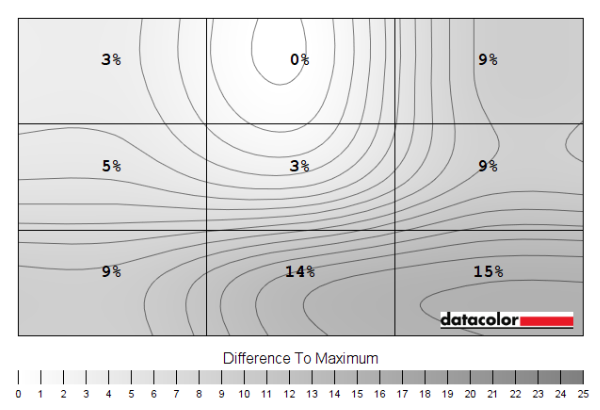
Luminance uniformity map 'Test Settings'
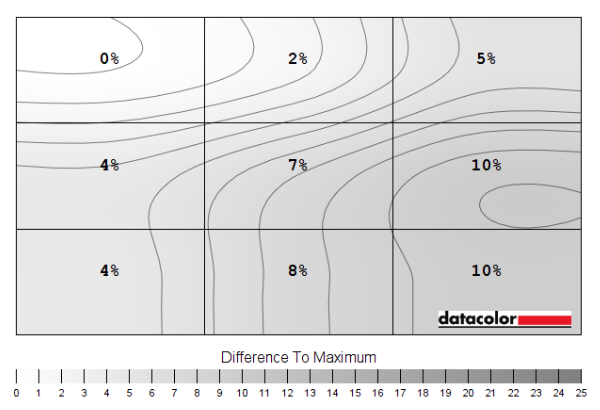
Luminance uniformity map 'SmartUniformity'
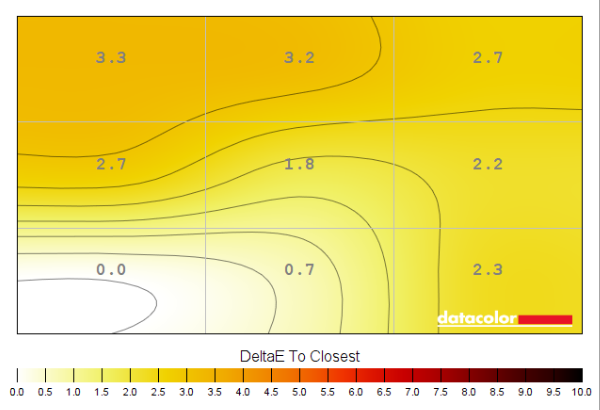
Colour temperature uniformity map 'Test Settings'
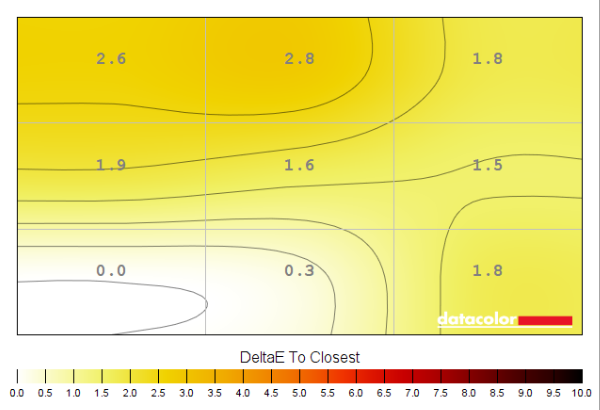
Colour temperature uniformity map 'SmartUniformity'
Contrast in games and movies
Lagom contrast tests
Colour reproduction
Colour gamut
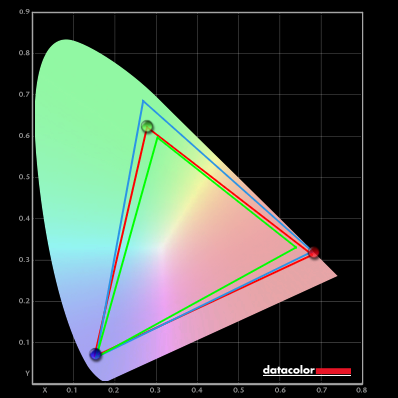
Colour gamut 'Test Settings'
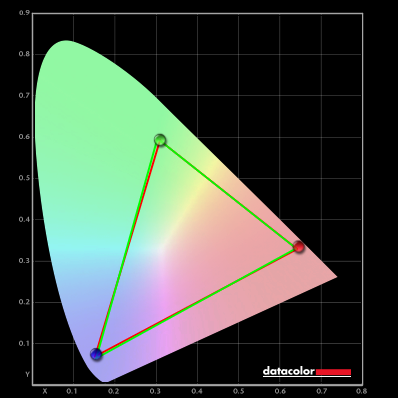
Colour gamut 'sRGB'

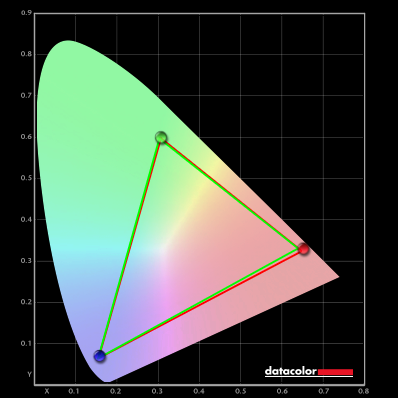
Colour gamut AMD 'CTC disabled' setting
Colour in games and movies
Shade representation using SpyderCHECKR 24
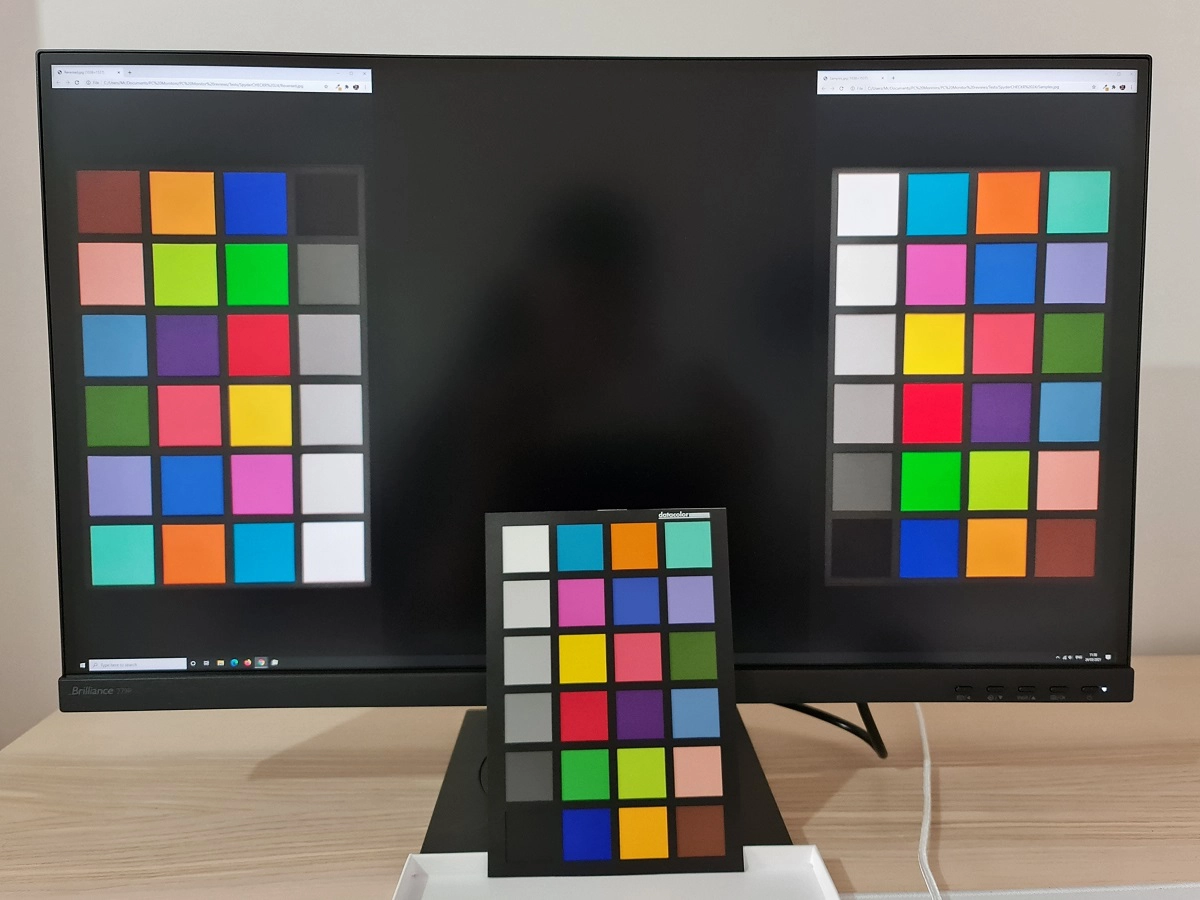
The monitor presents shades in quite a vibrant way with a bit of extra saturation. The extension in the gamut for some red shades is evident for shades such as medium orange (3) which looks to have more depth and saturation than intended and candy apple red (14) which is represented in an eye-catching and somewhat neon way. Although not to the extent seen on some wide gamut models. Gamboge (23) has a bit more of a saffron (orange) quality than intended. Peach pink (20) and light chocolate brown (24) have a slightly warm cast, with red elements brought out a bit strongly. To the eye light chocolate brown appears a bit deeper and richer than it does in the photo. The extension in the gamut beyond sRGB for some green elements provides some extra vibrancy to dark lime green (18), which verges a bit towards a more neon representation of the screen.
Viewing angles

The video below shows the Lagom text test, a mixed desktop background, game scene and dark desktop background from various viewing angles. You can see relatively minor colour shifts for the mixed desktop background and game scene, certainly less than VA or TN models. There’s a touch more ‘hazing’ (contrast loss) from sharper angles compared to some of the strongest IPS-type performers, although less than some IPS-type models. The dark desktop background highlights ‘IPS glow’, which blooms out as viewing angle increases. This generally appears a cool or slightly greenish-grey shade, sometimes slightly warmer depending on angle.
Interlace pattern artifacts
Responsiveness
Input lag
Perceived blur (pursuit photography)

Responsiveness in games and movies

VRR (Variable Refresh Rate) technology
FreeSync – the technology and activating it


The Philips supports a variable refresh rate range of 40 – 60Hz. That means that if the game is running between 40fps and 60fps, the monitor will adjust its refresh rate to match. When the frame rate rises above 60fps, the monitor will stay at 60Hz and the GPU will respect your selection of ‘VSync on’ or ‘VSync off’ in the graphics driver. With ‘VSync on’ the frame rate will not be allowed to rise above 60fps, at which point VSync activates and imposes the usual associated latency penalty. With ‘VSync off’ the frame rate is free to climb as high as the GPU will output (potentially >60fps). LFC (Low Frame Rate Compensation) is not supported by this monitor, as that requires the upper limit (ceiling) to be at least 2x the lower limit (floor) of FreeSync operation. FreeSync is therefore deactivated if the frame rate falls below 40fps, with the monitor then respecting your choice of VSync and presenting you with either stuttering (VSync on) or tearing (VSync off).

Some users prefer to leave VSync enabled but use a frame rate limiter set a few frames below the maximum supported (e.g. 57fps) instead, avoiding any VSync latency penalty at frame rates near the ceiling of operation or tearing from frame rates rising above the refresh rate. As a useful indicator that the technology is active, the refresh rate displayed in the OSD under ‘Setup’ – ‘Information’ updated in real time to reflect the frame rate of the content whilst within the VRR window (40 – 60Hz). Finally, it’s worth noting that FreeSync only removes stuttering or juddering related to mismatches between frame rate and refresh rate. It can’t compensate for other interruptions to smooth game play, for example network latency or insufficient system memory. Some game engines will also show stuttering (or ‘hitching’) for various other reasons which won’t be eliminated by the technology.
FreeSync – the experience
Nvidia Adaptive-Sync (‘G-SYNC Compatible’)

You will also see in the image above that it states: “Selected Display is not validated as G-SYNC Compatible.” This means Nvidia hasn’t specifically tested and validated the display, not that it won’t work. On our RTX 3090 the experience was very similar to what we described with FreeSync. With the technology getting rid of tearing and stuttering from what would otherwise be frame and refresh rate mismatches, between 40 – 60Hz (40 – 60fps). Our suggestions regarding use of VSync also apply, but you’re using Nvidia Control Panel rather than AMD Radeon Software to control this. The setting is found in ‘Manage 3D settings’ under ‘Vertical sync’, where the final option (‘Fast’) is equivalent to AMD’s ‘Enhanced Sync’ setting. You’ll also notice ‘G-SYNC Compatible’ listed under ‘Monitor Technology’ in this section, as shown below. Make sure this is selected (it should be if you’ve set everything up correctly in ‘Set up G-SYNC’).
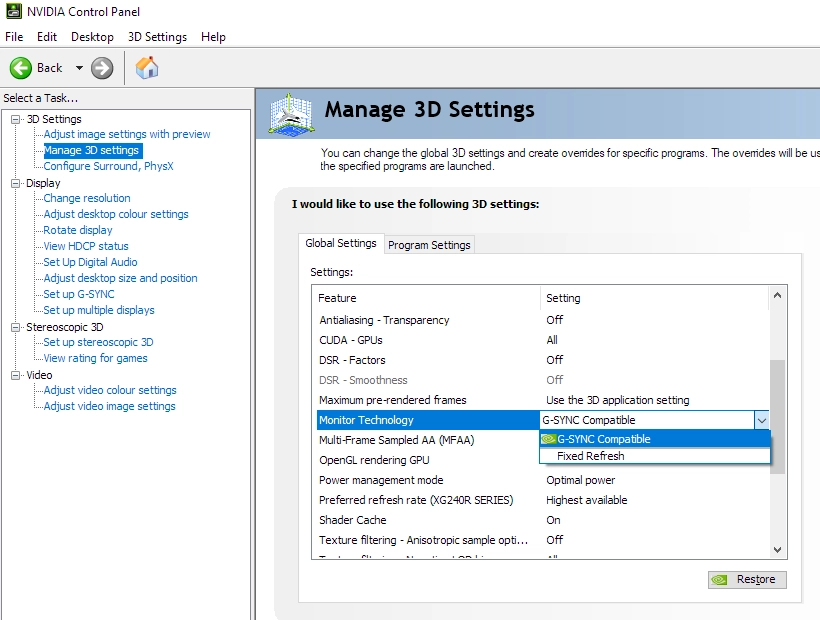
Finally, note that the refresh rate displayed in the OSD under ‘Setup’ – ‘Information’ updated in real time to reflect the frame rate of the content whilst within the VRR window (40 – 60Hz). This is a useful indication that the technology is active.
The ‘4K’ UHD experience


The strong pixel density also benefits suitably high resolution image content, ‘4K’ UHD movie content and games running in ‘4K’. Some game titles make better use of this than others, especially if high resolution textures and detailed particle effects are a focus. But even when playing older titles or modern titles with the graphics settings dialled down, there’s a certain definition that the high pixel density still brings. This is particularly noticeable as you stare into the distance in the game, where objects or characters in the game have a distinctness from their environment and a clarity that’s simply lacking with significantly lower pixel densities. The images below show the monitor in action in a selection of game titles. Again, they’re just for illustrative purposes and don’t accurately reflect how the monitor appears in person.

Interpolation and upscaling

The monitor includes a range of scaling settings in the ‘SmartSize’ section of the OSD, accessible only if Adaptive-Sync is disabled on the system. The default setting is ‘Panel Size’ which is set to ‘28”W (16:9)’. This uses an interpolation process, using all pixels of the monitor to display the image. This is used if Adaptive-Sync is active. There are also a range of emulation settings here of various screen sizes and aspect ratios. There’s a ‘1:1’ pixel mapping setting, only using the pixels called for by the source resolution, with a black border for remaining pixels. And an ‘Aspect’ setting which will use as many pixels as possible on the screen whilst maintaining the aspect ratio of the resolution selected. This section of the OSD video runs through these settings. As shown there, some resolutions don’t display as expected using the ‘Panel Size’ and ‘Aspect’ setting. The main ones considered here (Full HD and WQHD) will full up the entire screen using the default ‘Panel Size’ setting, whilst the ‘1:1’ setting always seems to work as intended regardless of resolution.
Video review
Timestamps:
Features & Aesthetics
Contrast
Colour reproduction
Responsiveness (General)
Responsiveness (Adaptive-Sync)
Conclusion
Positives Negatives Pleasing ‘out of the box’ setup, strong consistency and a fairly generous colour gamut delivered quite a vibrant but well-balanced image
DCI-P3 and Adobe RGB coverage insufficient for work within those colour spaces, sRGB emulation mode lacks flexibility and no HDR support Reasonable contrast performance and a light to very light screen surface providing quite direct emission of light without an obvious layered appearance Moderate ‘IPS glow’ ate away at detail and atmosphere, especially in dimmer conditions and a slightly grainy look to the screen surface Decent and well-tuned pixel responsiveness with quite low input lag. Adaptive-Sync worked well via both AMD FreeSync and Nvidia’s ‘G-SYNC Compatible Mode’ Slight weaknesses in pixel responsiveness for some transitions, but nothing extreme Competitively priced with good ergonomics. An excellent pixel density, providing good detail and clarity with excellent on-screen ‘real estate’ potential No swivel or pivot adjustment to stand, only plastics used for outer materials


